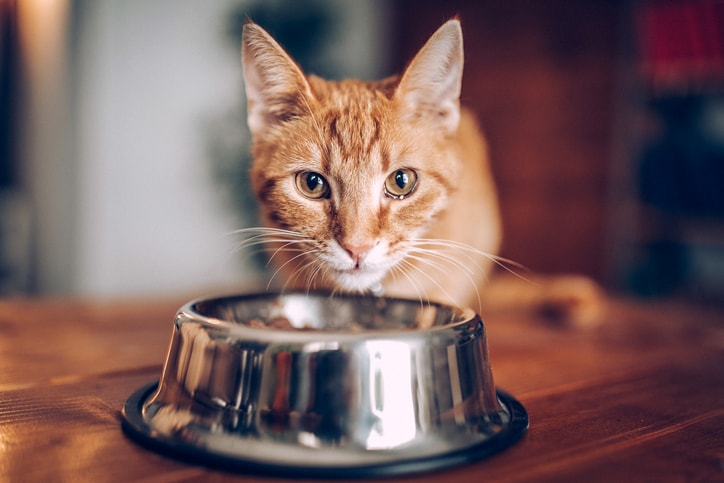Your cat’s bowl is half-full, but they keep meowing hungrily until you top it off. Behaviours like refusing to eat unless their bowl is full, or showing reluctance to eat in general, can be more than just dinnertime dramatics. One possible reason for your cat’s fussiness around food could be an uncomfortable phenomenon known as whisker fatigue, or whisker stress.
Whisker fatigue occurs when a cat’s whiskers are overstimulated, leading to discomfort. This usually happens when cats eat from bowls that require them to immerse their entire face to access the food.
Read on to find out how to prevent whisker fatigue and how to spot other common reasons cats may experience pain or discomfort while eating.
What is whisker fatigue?
Whiskers are connected to a cat’s autonomic (unconscious) nervous system, and whisker fatigue happens when they repeatedly receive and transmit an excess of sensory information. This overstimulation can lead to stress for the cat.
For us humans to better understand how cats may experience whisker fatigue, it’s important to recognize that their whiskers are more than just hairs. These delicate structures play a crucial role in how cats perceive and interact with their surroundings.
Embedded deeply in the cat’s skin, whiskers have highly sensitive nerve endings that enable cats to detect even the most subtle of changes in their surroundings. They use them to gauge the width of spaces and sense nearby objects and even changes in air currents, abilities that help them hunt and avoid obstacles in the dark.
Your cat’s whiskers are, in a way, like a human’s eyelashes. Just as a piece of dust on your eyelash will make you blink, the sensation of your cat’s bowl against their whiskers may be hard to ignore.
Signs of whisker fatigue in cats
Cats are notorious for hiding signs of discomfort, so the signs of eating issues can be subtle. The following behaviours are potential signs of whisker fatigue:
- Hesitation before eating.
- Only eating from the centre of the bowl.
- Using paws to tip or scoop food or water from bowls.
- Acting hungry but refusing to eat.
- Agitation around mealtimes.
Is whisker fatigue a myth?
Whisker fatigue is a relatively new concept. Many cat experts are sceptical about whether or not this phenomenon truly exists, as it is not widely covered in veterinary textbooks or scientific journals. However, anecdotal evidence suggests that at least some cats prefer to keep their whiskers free during mealtimes. The issue is still being investigated by veterinary scientists.
A 2020 study published by the Journal of Feline Medicine and Surgery evaluated forty cats for whisker fatigue. Subjects did not seem to experience eating issues when fed from a typical bowl, though around three in four cats seemed to prefer using a whisker-friendly dish. More research will have to be done before we can make any definitive conclusions.
How to prevent whisker fatigue in cats
Whether your cat shows signs of discomfort or you just want to ensure they have the best possible eating experience, consider feeding them from a shallow plate or an elevated, whisker-friendly cat bowl that allows for a more natural posture and reduces contact with the whiskers.
Switching from a water bowl to an automatic water fountain, too, can help improve your cat’s comfort. The flowing water is not only less likely to brush against your cat’s whiskers, but can also help your cat stay healthy and hydrated.
What if it’s not whisker fatigue?
While many cats seem to prefer eating from a whisker-friendly plate, there’s an important caveat: if eating issues are brushed off as whisker fatigue, a more serious underlying issue may be left unchecked.
Issues that may be mistaken for whisker fatigue include:
- Dental pain. Around 75% of cats over age three have signs of dental disease, according to The Feline Hospital. A painful infection or abscess can make it difficult for your cat to eat.
- Competition between other pets. Your cat may need a private space to eat if they feel bullied over resources like food and water.
- Gastrointestinal issues. These are common in cats and they may experience occasional inappetence, but if your cat frequently skips out on meals or refuses to eat for more than 24 hours, it’s time to visit your veterinarian.
Don’t worry if your cat prefers to graze, rather than finish their food at mealtimes. Nibbling at their food throughout the day is completely normal behaviour and not necessarily a sign of whisker fatigue.
The bottom line
Based on anecdotal reports from experts and a small study, cats may experience whisker fatigue when eating or drinking from a vessel with high sides. Switching to a flat, whisker-friendly food bowl should help, but if your cat still seems to have trouble eating, make an appointment with your veterinarian.
If you think your cat might be experiencing whisker fatigue or other behavioural issues, consulting a cat behaviourist or trainer can be helpful. They can offer expert advice tailored to your cat’s needs and guide you in making decisions to ensure their comfort and well-being.
